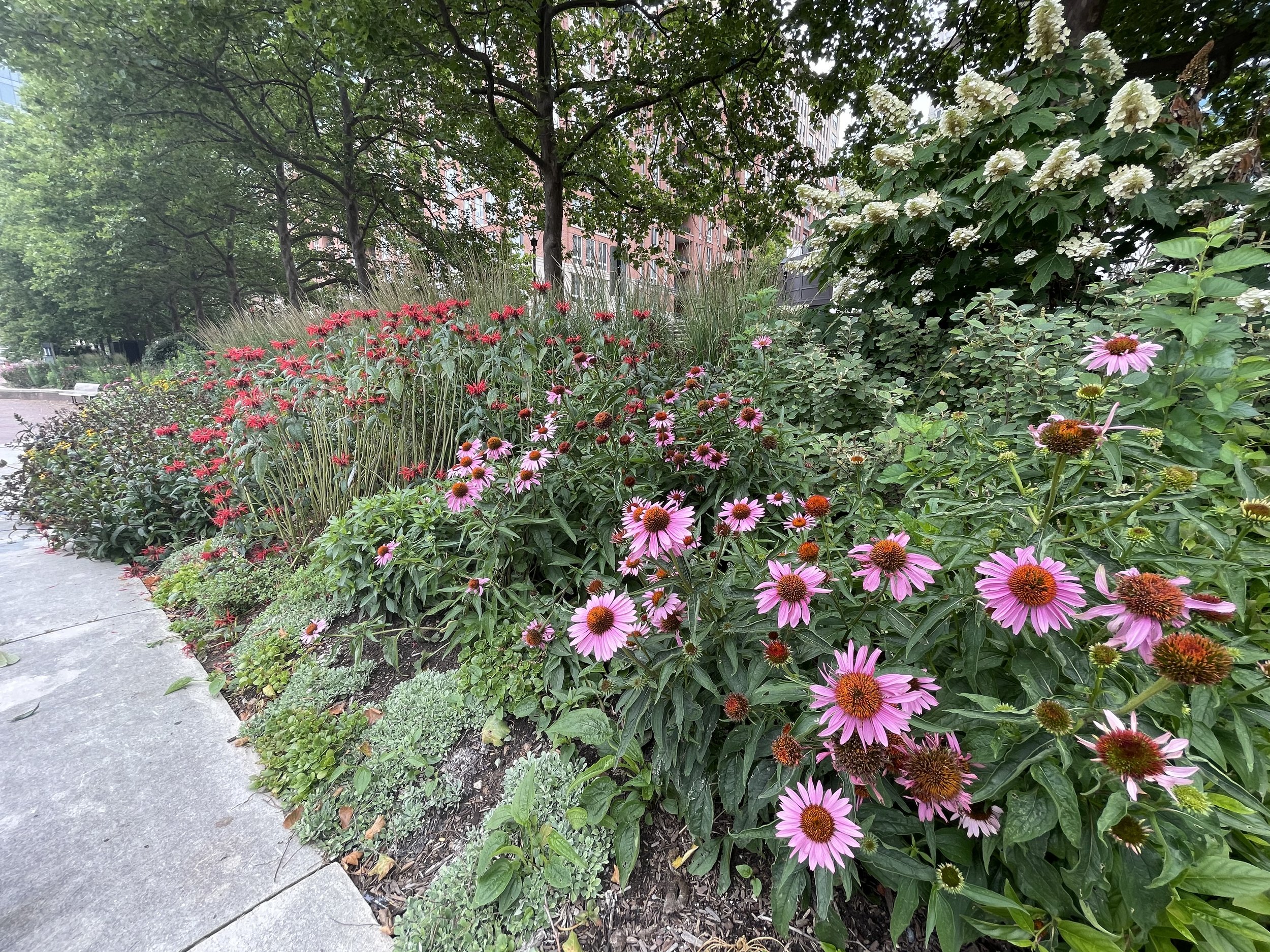Harbor Habitats
A habitat is a place where an organism makes its home. For the Inner Harbor, both the water and land-side play critical roles in supporting habitat and our local ecosystem, and ultimately contribute the health of our city.
A healthy habitat meets all the environmental conditions an organism needs to survive. For insects like butterflies and bees, and reptiles like turtles, our restoration goals are to provide everything they need to find and gather food, shelter, mate, and reproduce.Stewarding our land-side habitats include building and maintaining gardens that are planted with native perennials and include creative and informative habitat features such as bee boxes, insect hotels, bat boxes, and floating islands for our turtles!

Rain Gardens
Waterfront Partnership maintains multiple Native Rain Gardens that are integrated into the public spaces along the promenade that help reduce storm water runoff by slowing down the flow of water through absorption and naturally filtering it through the soil.
Native plants are adapted to the local climate and soil conditions where they naturally occur and provide nectar, pollen, and seeds that serve as food for native butterflies, insects, birds and other fauna. The native rain gardens feature Echinacea, Susan’s and native grasses such as Purple Love Grass that all provide habitat for swallowtails, bees, and larvae.

Nature Walk
Throughout the Inner Harbor you’ll encounter various Native plants that naturally occur in the region in which they evolved. Because native plants are adapted to local soils and climate conditions, they generally require less watering and fertilizing than non-natives.
Natives are often more resistant to insects and disease, and so are less likely to need pesticides. Wildlife evolved with plants; therefore, they use native plant communities for food, cover and rearing young. Using native plants helps preserve the balance and beauty of natural ecosystems.

Explore the Harbor like never before with our in-depth guided tours!
Go at your own pace with our selection of self-guided tours!

Turtle Island
In April 2022, Waterfront Partnership teamed up with the National Aquarium, Living Classrooms Foundation, and Clearwater Mills to install the Harbor’s first Turtle Island. Turtles are cold-blooded and need to warm up to digest their food. Turtle Island provides places or turtles to bask, sleep, and forage. Dozens of turtles can be seen enjoying the island at a time – especially in the early spring when the Harbor is still very cold. You can find Turtle Island in the Lancaster Canal near the intersection of S. Caroline and Lancaster Streets.

Floating Wetlands
Floating Wetlands recreate the natural wetland environment that was found in the Baltimore Harbor prior to the Industrial Revolution. Historically, most of the Inner Harbor was covered with wetlands that were home to a diverse range of animals including oysters, otters, herons, and blue crabs. Today, little natural shoreline remains. So, if we wanted to restore even a fraction of that ecosystem, we would need to get creative. Floating wetlands are anchored in place and use pontoons to float and move up and down with the changing tides. Each floating island is planted with native plants and grasses that provide habitat for small fish, birds, and insects. The plants also help to filter the water by removing excess nutrient pollution and storing it in their leaves as they grow. Over the last decade, the amount of floating wetlands in the Inner Harbor has increased from 200 to 2,000 square feet, and the National Aquarium has ambitious plans for even more to come!

Bug Hotels
Waterfront Partnership is working to make Baltimore Harbor a sanctuary for local wildlife. In spring, 2022, bug hotels were installed near conservation gardens in Pierce’s Park and along the promenade in Harbor East. These bug hotels create habitat for local insects by replicating the environment they seek in the wild.
They feature bamboo and wood for nesting bees, pine cones for lady bugs, and bark for beetles and spiders. The bug hotels were built by Baltimore city youth enrolled in the Living Classroom Foundation’s Fresh Start program.

Keep Up On The Weekly Buzz
Whether you live a few steps from the waterfront or take the occasional trip to visit, Harbor Beat is your source for local news, community events, historical insights, food & wine recommendations, and district updates.








